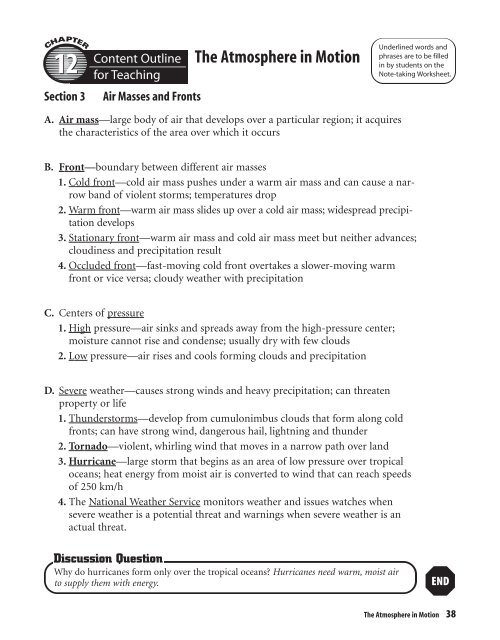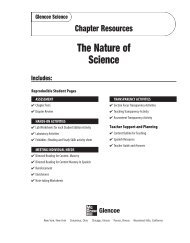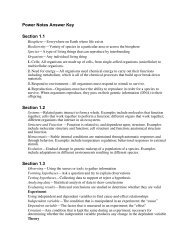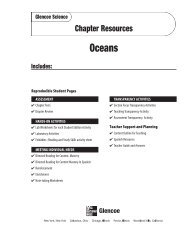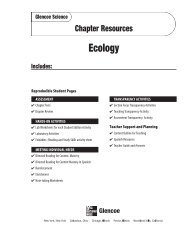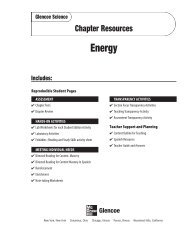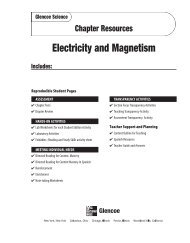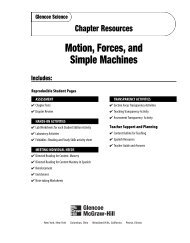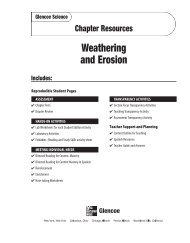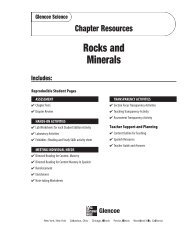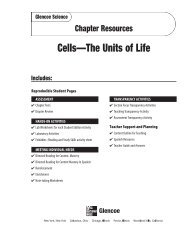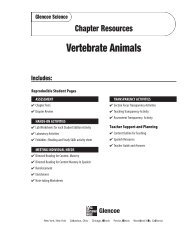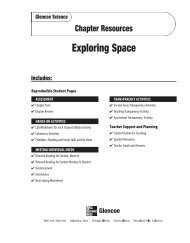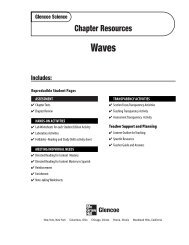Content Outline for Teaching - Potosi School District - Home
Content Outline for Teaching - Potosi School District - Home
Content Outline for Teaching - Potosi School District - Home
You also want an ePaper? Increase the reach of your titles
YUMPU automatically turns print PDFs into web optimized ePapers that Google loves.
12<br />
Section 3<br />
<strong>Content</strong> <strong>Outline</strong><br />
<strong>for</strong> <strong>Teaching</strong><br />
Air Masses and Fronts<br />
The Atmosphere in Motion<br />
Underlined words and<br />
phrases are to be filled<br />
in by students on the<br />
Note-taking Worksheet.<br />
A. Air mass—large body of air that develops over a particular region; it acquires<br />
the characteristics of the area over which it occurs<br />
B. Front—boundary between different air masses<br />
1. Cold front—cold air mass pushes under a warm air mass and can cause a narrow<br />
band of violent storms; temperatures drop<br />
2. Warm front—warm air mass slides up over a cold air mass; widespread precipitation<br />
develops<br />
3. Stationary front—warm air mass and cold air mass meet but neither advances;<br />
cloudiness and precipitation result<br />
4. Occluded front—fast-moving cold front overtakes a slower-moving warm<br />
front or vice versa; cloudy weather with precipitation<br />
C. Centers of pressure<br />
1. High pressure—air sinks and spreads away from the high-pressure center;<br />
moisture cannot rise and condense; usually dry with few clouds<br />
2. Low pressure—air rises and cools <strong>for</strong>ming clouds and precipitation<br />
D. Severe weather—causes strong winds and heavy precipitation; can threaten<br />
property or life<br />
1. Thunderstorms—develop from cumulonimbus clouds that <strong>for</strong>m along cold<br />
fronts; can have strong wind, dangerous hail, lightning and thunder<br />
2. Tornado—violent, whirling wind that moves in a narrow path over land<br />
3. Hurricane—large storm that begins as an area of low pressure over tropical<br />
oceans; heat energy from moist air is converted to wind that can reach speeds<br />
of 250 km/h<br />
4. The National Weather Service monitors weather and issues watches when<br />
severe weather is a potential threat and warnings when severe weather is an<br />
actual threat.<br />
Discussion Question<br />
Why do hurricanes <strong>for</strong>m only over the tropical oceans? Hurricanes need warm, moist air<br />
to supply them with energy.<br />
The Atmosphere in Motion 38


